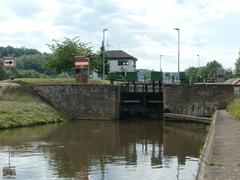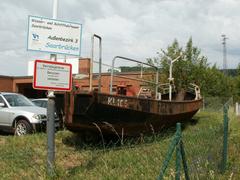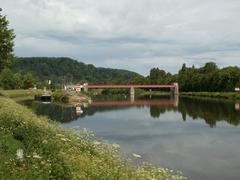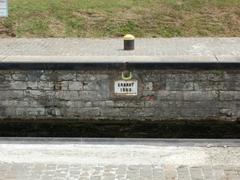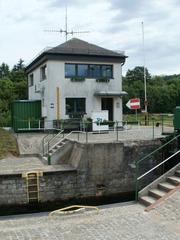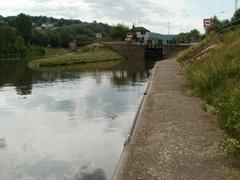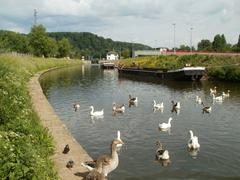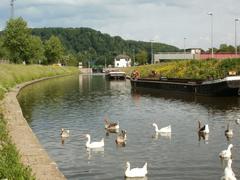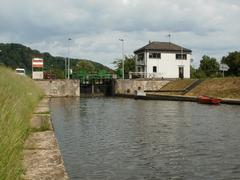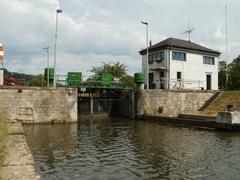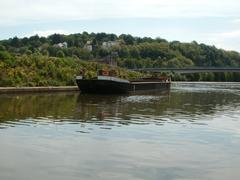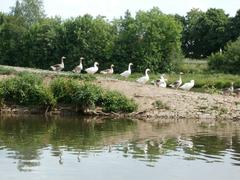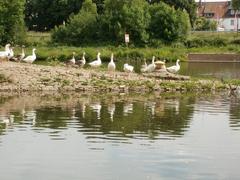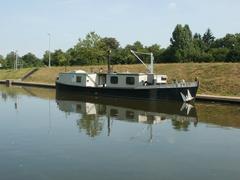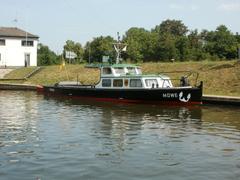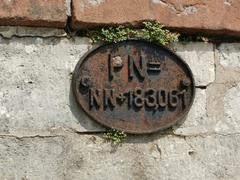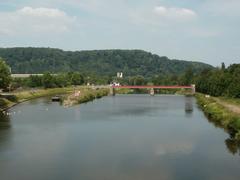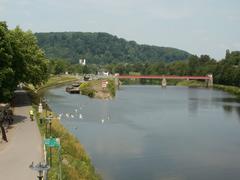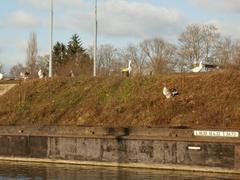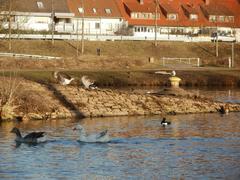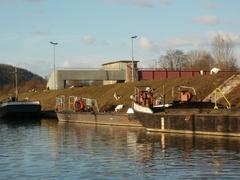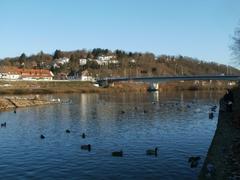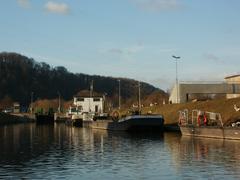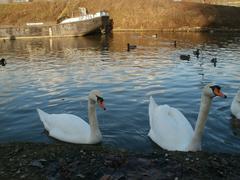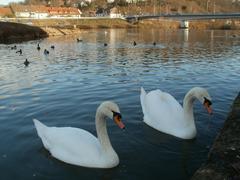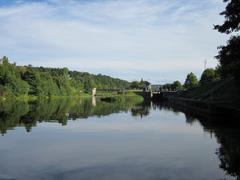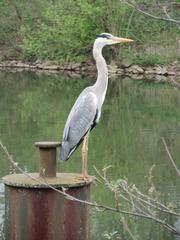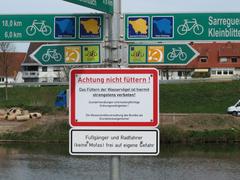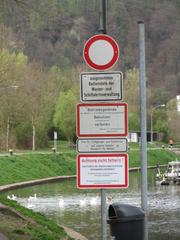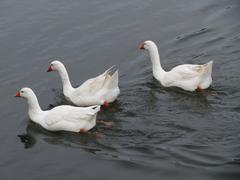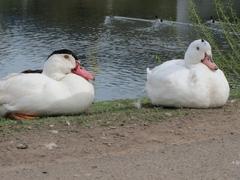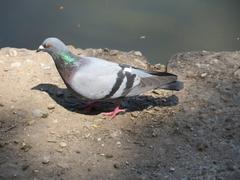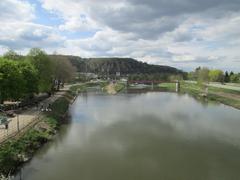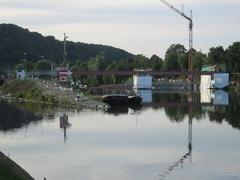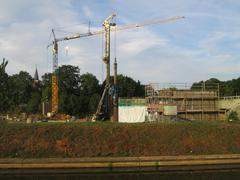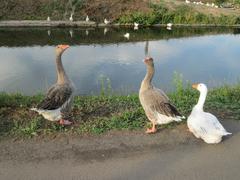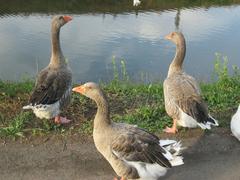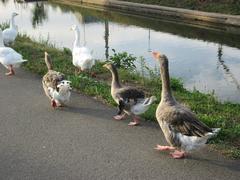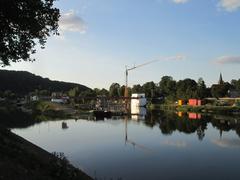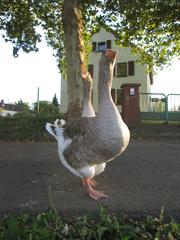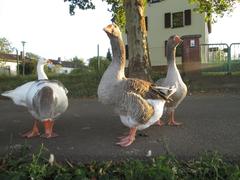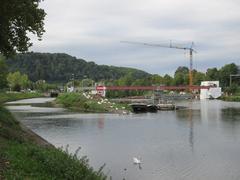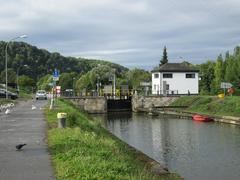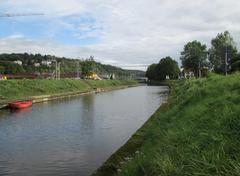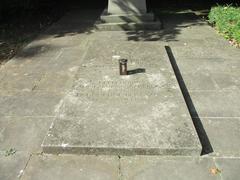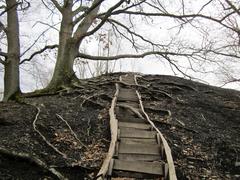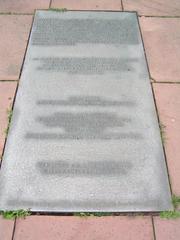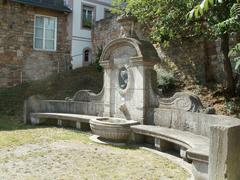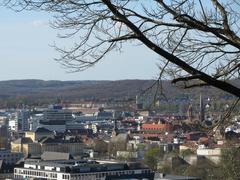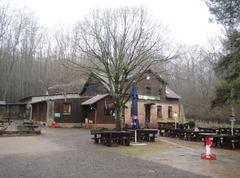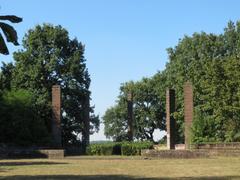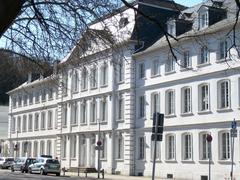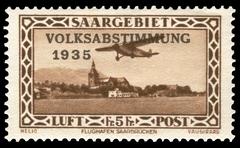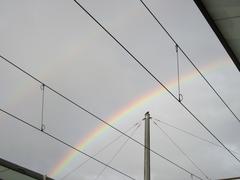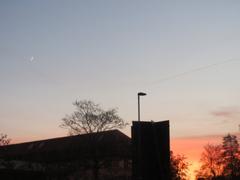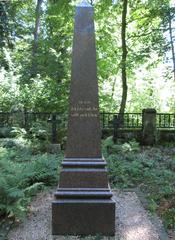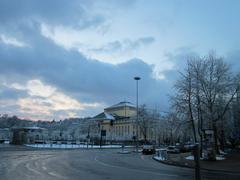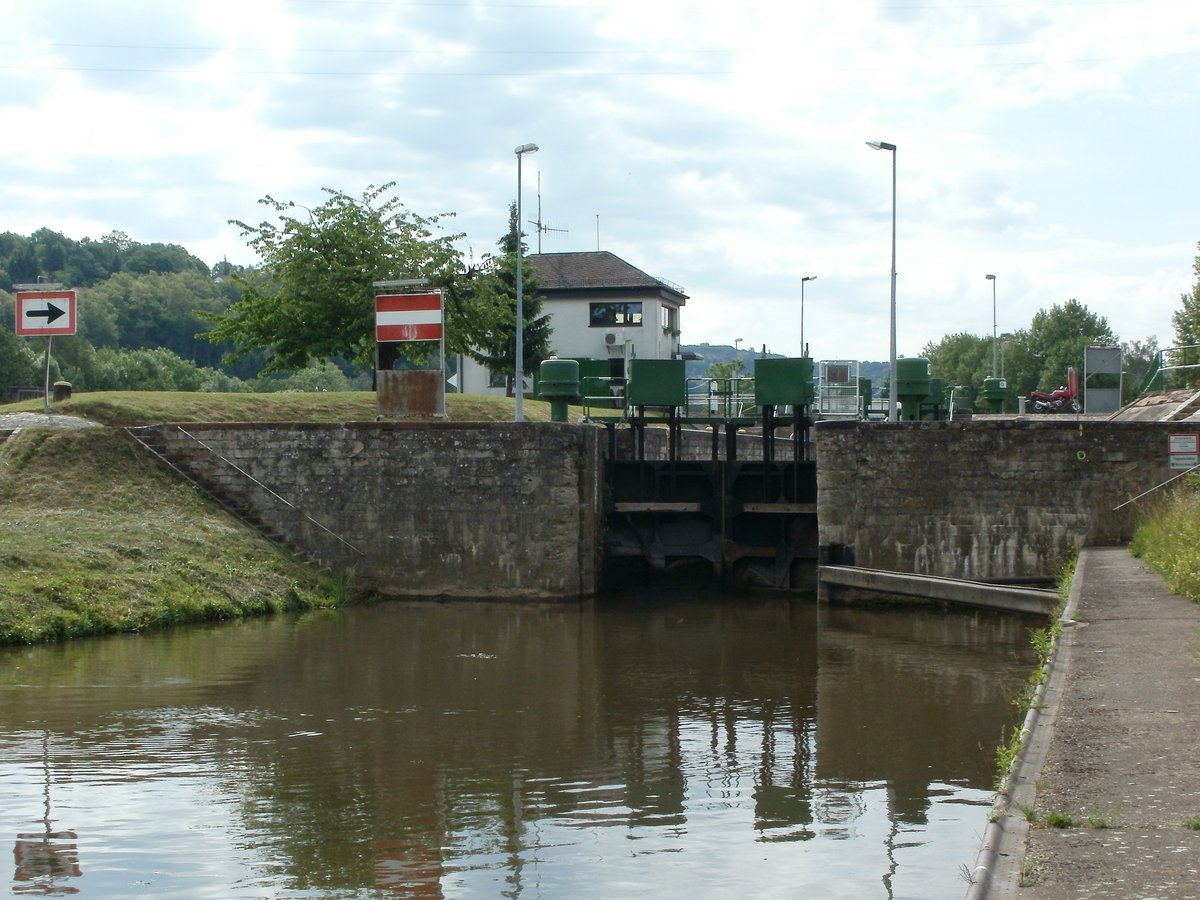
Complete Guide to Visiting Güdingen Lock, Saarbrücken, Germany: Visiting Hours, Tickets, and Nearby Attractions
Date: 14/06/2025
Introduction
Nestled in the district of Güdingen, just 4 kilometers southeast of Saarbrücken’s city center, Güdingen Lock (Schleuse Güdingen) is a landmark of 19th-century hydraulic engineering and a testament to the region’s rich industrial heritage. Originally constructed in 1863 as part of a sweeping effort to canalize the Saar River, the lock played a critical role during the coal mining and steel production boom, driving Saarbrücken’s emergence as an industrial hub. Today, it functions as both a key node in the European inland waterway network and an intriguing historical site for visitors of all ages.
At Güdingen Lock, visitors can observe commercial and leisure vessels navigating the lock system, explore scenic riverside trails, and gain insights into the area’s role in regional commerce and cross-border cooperation. The lock’s proximity to the UNESCO Biosphere Reserve Bliesgau, Saarbrücken Castle, Ludwigskirche, and the Cold War-era Zivilschutzanlage Güdingen bunker museum further enriches the visitor experience.
This comprehensive guide covers visiting hours, ticket information, accessibility, travel tips, and highlights nearby attractions and activities. For those seeking deeper engagement, digital resources like the Audiala mobile app offer audio tours and exclusive content on Güdingen Lock and Saarbrücken’s historical sites.
For more details, consult the Saarbrücken Tourism Board website or the official Saarhafen site.
Table of Contents
- Introduction
- Brief History
- Visitor Information
- Getting There & Travel Tips
- Architectural & Engineering Highlights
- Güdingen Lock in the European Waterway Network
- Technical Features & Operation
- Economic & Strategic Importance
- Cultural & Touristic Significance
- Environmental & Engineering Considerations
- What to See and Do
- Facilities & Amenities
- Events & Activities Near Güdingen Lock
- Safety & Visitor Etiquette
- Photography & Educational Opportunities
- Practical Tips
- FAQs
- Sustainability & Responsible Tourism
- Summary & Final Recommendations
- References
Brief History of Güdingen Lock
Constructed in 1863, Güdingen Lock was part of a major 19th-century initiative to canalize the Saar River and improve inland navigation throughout Europe. Its strategic position transformed Saarbrücken and its environs into an industrial powerhouse during the coal and steel boom. The lock complex, which includes a weir and the distinctive 1936 lock keeper’s house, is now a protected historic monument. It showcases the evolution of river navigation and the region’s industrial architecture.
Visitor Information
Visiting Hours
Güdingen Lock is an open-air historical site, accessible to the public year-round during daylight hours—typically from 8:00 AM to 8:00 PM, though hours may vary seasonally. There is no formal visitor center.
Tickets
Admission is free. Occasionally, local heritage organizations or tourism offices may offer guided tours or special events, which may require booking or a small fee. Always verify upcoming events in advance.
Accessibility
Most paths around the lock are flat and paved, suitable for visitors with limited mobility and wheelchair users. Some riverside areas may have uneven surfaces, so take care near the water.
Guided Tours & Special Events
Special guided tours highlighting the lock’s engineering and historical significance are occasionally offered by local heritage groups or the Saarbrücken Tourism Board. For details and schedules, check their official website.
Getting There & Travel Tips
- By Car: Easily reached via the A620 motorway (Saarbrücken-Güdingen exit), B51, and local roads. Parking is available along Saargemünder Straße, Friedrich-Ebert-Straße, and Bahnstraße, but can be limited during events.
- By Public Transport: Saarbahn tram line S1 and local bus lines connect Güdingen with Saarbrücken city center. The nearest train station is Saarbrücken-Güdingen, roughly 1 km from the lock (SaarVV).
- By Bicycle: The lock is part of the Saar Cycle Route, offering scenic flat access for cyclists.
Architectural & Engineering Highlights
The lock comprises a robust chamber, adjacent weir for water regulation, and the 1936 lock keeper’s house. Built of durable masonry and ironwork, it reflects 19th-century engineering. The lock is harmoniously set within the river landscape, making it a pleasant stop for observation and photography.
Güdingen Lock in the European Waterway Network
The lock is a vital link in the Saar River’s canalized stretch, connecting to major waterways such as the Mosel and Rhine. This class Vb European waterway supports large commercial vessels and underscores the lock’s strategic role in cross-border trade.
Technical Features & Operation
Güdingen Lock is the first major lock encountered by vessels entering Germany from France. It is a 40-meter Freycinet lock, common on French waterways, and supports ships up to 85 meters long, 9.5 meters wide, and 2.5 meters draft. Modern signaling and VHF radio allow efficient communication between vessels and the lock keeper. Approaching boats are guided by traffic lights and instructions for safe passage (canallocks.blogspot.com).
Economic & Strategic Importance
As the gateway between France and Germany, the lock has played a critical role in facilitating the movement of industrial goods, especially coal and steel. Managed by the Wasser- und Schifffahrtsamt Saarbrücken, it remains important for commercial shipping and recreational boating alike (theca.org.uk).
Cultural & Touristic Significance
Situated near the UNESCO Biosphere Reserve Bliesgau, the lock is a scenic point for cyclists and hikers. Visitors can explore the nearby Zivilschutzanlage Güdingen bunker museum and Saarbrücken’s blend of French and German heritage. The lock area offers educational panels in German and sometimes English or French, making it accessible for international visitors (urlaub.saarland).
Environmental & Engineering Considerations
Major engineering works, including river cutoffs and embankments, have improved navigation and reduced flooding. The region’s biodiversity is protected as part of the Bliesgau biosphere, and efforts are made to minimize the ecological impact of river traffic (saarhafen.de).
What to See and Do
Observing Lock Operations
Watch commercial barges and pleasure boats as they transit the lock. The process of vessels entering the chamber, gates closing, and water levels adjusting is both fascinating and educational.
Riverside Walks & Cycling
The lock sits amid picturesque riverside trails, suitable for walking, jogging, or cycling. Marked routes such as the Felsenwege and Güdinger Berg trails offer scenic views (touren.saarland).
Boat Tours & River Cruises
A passenger boat landing stage near the lock offers river cruises during warmer months. Check with local operators or the tourist office for schedules.
Nearby Attractions
- The historic Protestant church (1778/79)
- Old schoolhouse (1845)
- The district’s oldest house (1623)
- Güdingen horse racing track, popular for events (pferderennen.com)
Facilities & Amenities
There are no ticket offices or dedicated visitor centers at Güdingen Lock. Benches and green areas are available for relaxation. Public restrooms can be found at nearby cafés and restaurants. Over ten dining venues in Güdingen offer local specialties and some feature riverside seating (saarbruecken.de).
Events & Activities Near Güdingen Lock
The lock is a favored spot during local celebrations, such as the biennial village festival and sporting events at the adjacent horse racing track. The area also hosts duathlon sporting events, with up-to-date information available on local websites (tv-guedingen.de, tourismus.saarbruecken.de).
Safety & Visitor Etiquette
- Stay behind barriers and heed posted signs
- Children must be closely supervised near the water
- Swimming is strictly prohibited
- Cyclists and pedestrians share the paths; be courteous
- Dogs are welcome but must be leashed
Photography & Educational Opportunities
The lock and riverside environment provide excellent photographic subjects, especially during morning and late afternoon. Onsite panels explain the lock’s function and history. Special educational visits can be arranged through the tourist office.
Practical Tips
- Best time to visit: Spring through early autumn for pleasant weather and active river traffic
- What to bring: Walking shoes, camera, binoculars, and appropriate clothing
- Accessibility: Main paths are suitable for wheelchairs and strollers
- Refreshments: Güdingen’s restaurants and bakeries offer local fare
- Combine activities: Pair your visit with a walk or cycle along the river, a meal, or attendance at local events
Frequently Asked Questions (FAQ)
Q: What are the visiting hours for Güdingen Lock?
A: Open year-round during daylight hours, typically 8:00 AM–8:00 PM.
Q: Are tickets required?
A: No, entry is free.
Q: Is the site accessible for people with disabilities?
A: Yes, main paths are flat and suitable for most visitors.
Q: Are guided tours available?
A: Occasionally, through the Saarbrücken tourist office.
Q: Are there public restrooms?
A: Not directly on-site, but available at nearby cafés and restaurants.
Q: Can I swim in the river near the lock?
A: No, swimming is strictly prohibited due to safety risks.
Sustainability & Responsible Tourism
Support local businesses, use public transport or bicycles, and respect the natural environment. Saarbrücken encourages sustainable tourism practices to preserve the Saar River and its historic sites.
Summary & Final Recommendations
Güdingen Lock embodies the intersection of engineering ingenuity, industrial legacy, and natural beauty in Saarbrücken and the Saarland region. As a functioning gateway on the European waterway network and a free public attraction, it offers a rich experience for visitors interested in history, nature, or river navigation.
With scenic riverside paths, nearby cultural landmarks, and occasional community events, Güdingen Lock is ideal for both leisurely exploration and in-depth historical discovery. The site’s accessibility and integration with regional cycling and hiking routes make it a welcoming destination for all.
For the latest details, upcoming events, and guided tours, consult the Saarbrücken Tourism Board and the official Saarhafen website. Download the Audiala app for audio tours and travel tips, and follow Saarbrücken’s social channels for updates.
References
- Güdingen Lock in Saarbrücken: Visiting Hours, Tickets, History & Travel Tips (Saarbrücken Tourism Board)
- Visiting Güdingen Lock in Saarbrücken: Hours, Tickets, and Things to Do Near This Historic Waterway (Saarhafen)
- Güdingen Lock Visiting Hours, Tickets & Guide to Saarbrücken’s Historic Waterway (Stadtteil Güdingen)
- Visiting Güdingen Lock: Hours, Tickets, and Saarbrücken Historical Sites Guide (Tourist Information)
- Technical details and lock operations (canallocks.blogspot.com)
- Waterway network information (theca.org.uk)
- Bliesgau biosphere and tourism (urlaub.saarland)
- Cycling and hiking routes (touren.saarland)
- Horse racing events (pferderennen.com)
- Local duathlon events (tv-guedingen.de)
- Event calendar (tourismus.saarbruecken.de)
